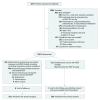Effect of Lung Recruitment and Titrated Positive End-Expiratory Pressure (PEEP) vs Low PEEP on Mortality in Patients With Acute Respiratory Distress Syndrome: A Randomized Clinical Trial
- PMID: 28973363
- PMCID: PMC5710484
- DOI: 10.1001/jama.2017.14171
Effect of Lung Recruitment and Titrated Positive End-Expiratory Pressure (PEEP) vs Low PEEP on Mortality in Patients With Acute Respiratory Distress Syndrome: A Randomized Clinical Trial
Abstract
Importance: The effects of recruitment maneuvers and positive end-expiratory pressure (PEEP) titration on clinical outcomes in patients with acute respiratory distress syndrome (ARDS) remain uncertain.
Objective: To determine if lung recruitment associated with PEEP titration according to the best respiratory-system compliance decreases 28-day mortality of patients with moderate to severe ARDS compared with a conventional low-PEEP strategy.
Design, setting, and participants: Multicenter, randomized trial conducted at 120 intensive care units (ICUs) from 9 countries from November 17, 2011, through April 25, 2017, enrolling adults with moderate to severe ARDS.
Interventions: An experimental strategy with a lung recruitment maneuver and PEEP titration according to the best respiratory-system compliance (n = 501; experimental group) or a control strategy of low PEEP (n = 509). All patients received volume-assist control mode until weaning.
Main outcomes and measures: The primary outcome was all-cause mortality until 28 days. Secondary outcomes were length of ICU and hospital stay; ventilator-free days through day 28; pneumothorax requiring drainage within 7 days; barotrauma within 7 days; and ICU, in-hospital, and 6-month mortality.
Results: A total of 1010 patients (37.5% female; mean [SD] age, 50.9 [17.4] years) were enrolled and followed up. At 28 days, 277 of 501 patients (55.3%) in the experimental group and 251 of 509 patients (49.3%) in the control group had died (hazard ratio [HR], 1.20; 95% CI, 1.01 to 1.42; P = .041). Compared with the control group, the experimental group strategy increased 6-month mortality (65.3% vs 59.9%; HR, 1.18; 95% CI, 1.01 to 1.38; P = .04), decreased the number of mean ventilator-free days (5.3 vs 6.4; difference, -1.1; 95% CI, -2.1 to -0.1; P = .03), increased the risk of pneumothorax requiring drainage (3.2% vs 1.2%; difference, 2.0%; 95% CI, 0.0% to 4.0%; P = .03), and the risk of barotrauma (5.6% vs 1.6%; difference, 4.0%; 95% CI, 1.5% to 6.5%; P = .001). There were no significant differences in the length of ICU stay, length of hospital stay, ICU mortality, and in-hospital mortality.
Conclusions and relevance: In patients with moderate to severe ARDS, a strategy with lung recruitment and titrated PEEP compared with low PEEP increased 28-day all-cause mortality. These findings do not support the routine use of lung recruitment maneuver and PEEP titration in these patients.
Trial registration: clinicaltrials.gov Identifier: NCT01374022.
Conflict of interest statement
Figures



Comment in
-
Lung Recruitment and Titrated PEEP in Moderate to Severe ARDS: Is the Door Closing on the Open Lung?JAMA. 2017 Oct 10;318(14):1327-1329. doi: 10.1001/jama.2017.13695. JAMA. 2017. PMID: 28973075 Free PMC article. No abstract available.
-
Should the ART trial change our practice?J Thorac Dis. 2017 Dec;9(12):4871-4877. doi: 10.21037/jtd.2017.11.01. J Thorac Dis. 2017. PMID: 29312680 Free PMC article. No abstract available.
-
Lung Recruitment and Positive End-Expiratory Pressure Titration in Patients With Acute Respiratory Distress Syndrome.JAMA. 2018 Mar 6;319(9):933. doi: 10.1001/jama.2017.21840. JAMA. 2018. PMID: 29509859 No abstract available.
-
Lung Recruitment and Positive End-Expiratory Pressure Titration in Patients With Acute Respiratory Distress Syndrome.JAMA. 2018 Mar 6;319(9):933-934. doi: 10.1001/jama.2017.21844. JAMA. 2018. PMID: 29509860 No abstract available.
-
Lung Recruitment and Positive End-Expiratory Pressure Titration in Patients With Acute Respiratory Distress Syndrome.JAMA. 2018 Mar 6;319(9):932-933. doi: 10.1001/jama.2017.21856. JAMA. 2018. PMID: 29509861 No abstract available.
-
Higher vs. lower PEEP in ARDS: just one part of the whole.J Thorac Dis. 2018 Jan;10(1):56-59. doi: 10.21037/jtd.2017.12.46. J Thorac Dis. 2018. PMID: 29600021 Free PMC article. No abstract available.
-
Is there still a role for alveolar recruitment maneuvers in acute respiratory distress syndrome?J Thorac Dis. 2018 Jan;10(1):85-90. doi: 10.21037/jtd.2017.12.113. J Thorac Dis. 2018. PMID: 29600028 Free PMC article. No abstract available.
-
The 25th birthday and premature death of the open lung approach?-from science, through art, towards precision medicine.J Thorac Dis. 2018 Jan;10(1):135-137. doi: 10.21037/jtd.2017.12.118. J Thorac Dis. 2018. PMID: 29600040 Free PMC article. No abstract available.
-
Mechanical Ventilation in Acute Respiratory Distress Syndrome. Insights into Opening the Lung and Driving Pressure.Am J Respir Crit Care Med. 2018 Jul 1;198(1):117-119. doi: 10.1164/rccm.201711-2342RR. Am J Respir Crit Care Med. 2018. PMID: 29641219 Free PMC article. No abstract available.
-
Atelectrauma or volutrauma: the dilemma.J Thorac Dis. 2018 Mar;10(3):1258-1264. doi: 10.21037/jtd.2018.02.71. J Thorac Dis. 2018. PMID: 29707275 Free PMC article. No abstract available.
-
What does the Acute Respiratory Distress Syndrome trial (ART) teach us?-it is time for precision medicine and precision trials in critical care!J Thorac Dis. 2018 Mar;10(3):1300-1303. doi: 10.21037/jtd.2018.03.31. J Thorac Dis. 2018. PMID: 29707281 Free PMC article. No abstract available.
-
How I set up positive end-expiratory pressure: evidence- and physiology-based!Crit Care. 2019 Dec 16;23(1):412. doi: 10.1186/s13054-019-2695-z. Crit Care. 2019. PMID: 31842915 Free PMC article. No abstract available.
References
-
- Bellani G, Laffey JG, Pham T, et al. ; LUNG SAFE Investigators; ESICM Trials Group . Epidemiology, patterns of care, and mortality for patients with acute respiratory distress syndrome in intensive care units in 50 countries. JAMA. 2016;315(8):788-800. - PubMed
-
- Herridge MS, Tansey CM, Matté A, et al. ; Canadian Critical Care Trials Group . Functional disability 5 years after acute respiratory distress syndrome. N Engl J Med. 2011;364(14):1293-1304. - PubMed
-
- Gattinoni L, Marini JJ, Pesenti A, Quintel M, Mancebo J, Brochard L. The “baby lung” became an adult. Intensive Care Med. 2016;42(5):663-673. - PubMed
-
- Gattinoni L, Protti A, Caironi P, Carlesso E. Ventilator-induced lung injury: the anatomical and physiological framework. Crit Care Med. 2010;38(10)(suppl):S539-S548. - PubMed
-
- Amato MB, Barbas CS, Medeiros DM, et al. . Effect of a protective-ventilation strategy on mortality in the acute respiratory distress syndrome. N Engl J Med. 1998;338(6):347-354. - PubMed
Publication types
MeSH terms
Associated data
LinkOut - more resources
Full Text Sources
Other Literature Sources
Medical
Miscellaneous

